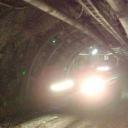JOURNALISM
Essays on “Communist in the Coalfields”
-
Ambush at Keystone: Inside the Coalminers’ Gas Protest
-
“Didn’t You see that Spirit Descend?” — Being Communist in the Bible Belt
-
Lightning Lane’s Last Day
-
Linc and Me: On the Material Basis of Incorrect ideas
-
The View from Dunne’s Porch
-
On Communist Work: That Feeling of Stage Diving in the Dark
-
Rape of Nature and the Need for a New Communist Approach
-
The Dead Miners in Sago: Dying for the Bottom Line
-
Untold Stories of Quecreek’s Flood: Coal Miners, Water and Heartless Capitalism
-
Letter 5: Particularities of Christians and Fascists
-
Most Recent: Blasted in a West Virginia Mine: First by Explosion, Then by Lies
* * * * * * * *
Strikers at Smithfield’s Tar Heel Slaughterhouse
No Longer Hidden, No Longer Hiding
by Mike Ely and Linda Flores, January 2007
Winter seems to strip the countryside of secrets. Driving along the two-lane, you can see deep into the gray stretches of dry pine forest and far across bare, open cotton fields.
But as night fell, as our contact took us farther and farther from the main road, it became obvious that many things about this corner of North Carolina have been carefully hidden.
“Roll down your window,” A. said. “Smell that.” The nose twitches. It almost burns. “The plant kills 32,000 hogs a day, many of them raised right around here.” A. gestures at the dark woods around us.
Modern industrial hog farming concentrates the swine and pours their untreated excrement into countless “lagoons” that fill acre after acre across North Carolina. The farms are tucked back away from any roads, but there is no hiding the pungent mist of manure that hangs across the land.
We turn left, then right. Dirt roads lead off on every side. People too are hidden here. Suddenly we are in a huge trailer park carved out of the pines. Rows of doublewides, with muscle trucks parked out front. “Michoacan” is spraypainted across a fender. “La Hacienda” is across a trunk lid.
Strike at Smithfield: Workers Under a Changing Sky
The Struggle Erupts
 “We came for the money,” José told us. And we heard those same words from all the immigrant workers who spoke with us on our trip to southeastern North Carolina.
“We came for the money,” José told us. And we heard those same words from all the immigrant workers who spoke with us on our trip to southeastern North Carolina.
The workers had come far north for the same wages that many Black workers consider intolerably low. Starting pay at Smithfield Foods’ massive hog-killing operation is $8 an hour. It is more in a day than José could make in a week in Guerrero, Mexico. One Black worker said to Revolution: “At these wages, we can barely live in a rundown house or trailer.”
Many immigrants are sending money home to family in Mexico and Guatemala, and dreaming of returning themselves, once they have saved “enough,” to build a house or buy a patch of land.
Under these conditions, thrown together by the workings of a global system of plunder, workers from different parts of the world have found themselves working side by side. And they often look at each other across a real divide created by their different experiences and different summations of how things came to be the way they are.
The Dead Miners in Sago
Dying for The Bottom Line
by Mike Ely, January 2006
“With all these roof falls and everything that has happened over the multiple months, not weeks, MONTHS, that this has happened, and they STILL send men in there?”
John Bennett, son of a Sago miner, confronting West Virginian Gov. Joe Manchin Today show, Jan. 4, 2005
 The miners knew the Sago Mine was unsafe. And their families in the surrounding towns knew it too. The slap-on-the-wrist fines of the mine inspectors left an unmistakable paper trail for everyone else — serious violations jumped four times in 2005 over 2004.
The miners knew the Sago Mine was unsafe. And their families in the surrounding towns knew it too. The slap-on-the-wrist fines of the mine inspectors left an unmistakable paper trail for everyone else — serious violations jumped four times in 2005 over 2004.
I went into the coal mines in the early 1970s–as part of a whole generation of revolutionary youth taking communism to the working class. And over the following years there would be times–when the rock was breaking up, or water was pouring through the mine roof, or when gas built up–and you would lie there just dreading the next day. Not wanting to go in. But not wanting to leave your crew to face it all alone. Or you’d watch as someone you knew was carried out, broken up or dead, and taken to a waiting ambulance. While we wrestled with that, together and alone, there is constantly that hard pull of working class life–the bills that need to be paid, the way danger just becomes part of life, and with that, the fact that working people are treated like this is all our lives are worth.
Untold Stories of Quecreek’s Flood
Coal Miners, Water and Heartless Capitalism
by Mike Ely, August 11, 2002
“Those are my brothers down there.”
Miner at the Quecreek rescue operations
“The scary part was watching the water rise and knowing that you don’t have a way out.”
Coalminer Dennis Hall after rescue
 Eight miners and a foreman went to work June 24. They left the afternoon daylight and entered the portal of Quecreek mine–traveling together through the darkness a mile-and-a-half horizontally, underground, to the working face of “1st Left Section.” And they divided up to their various jobs–grinding up the coal, securing the rock ceiling of the tunnels, and running the coal transport buggies to the conveyor belt.
Eight miners and a foreman went to work June 24. They left the afternoon daylight and entered the portal of Quecreek mine–traveling together through the darkness a mile-and-a-half horizontally, underground, to the working face of “1st Left Section.” And they divided up to their various jobs–grinding up the coal, securing the rock ceiling of the tunnels, and running the coal transport buggies to the conveyor belt.
Quecreek mine is only a year old. It is a small operation in southwestern Pennsylvania, employing 65 workers. The miners are still “driving” the basic tunnels forward, putting the belts and airways in place, so that the coal on this property can be systematically and completely removed over a decade. There is no union at Quecreek.
As the world now knows, these nine men were pushing forward to the boundary line–to the edge of the coal leased by Black Wolf Coal Company. They were heading straight for the old works of the Saxman Mine that had been dug and then abandoned in the 1950s.
Available online at mikeely.wordpress.com. Send comments to: m1keely (at) yahoo (dot) com
Published: December 2007. Feel free to reprint, distribute or quote this with attribution. This website’s contents are licensed under a Creative Commons Attribution 3.0 U.S. License.







National Students federation (NSF) India said
NATIONAL STUDENTS FEDERATION (NSF) INDIA
NATIONAL STUDENTS FEDERATION(NSF)INDIA IS A REVOLUTIONARY STUDENTS ORGANISATION. NSF LAUNCHED IN 1990 IN AMRITSAR CITY, THE STATE OF PUNJAB IN INDIA. REVOLUTIONARY STUDENTS OF AISSF,NSUI,SFI AND PSU ADOPED NEW REVOLUTIONARY LINE OF INDIAN NATIONALISM. WE SUPORTS LEFT AND NATIONALIST DEMOCRATIC AND REVOLUTIONAY FORCES. WE THINK INDIA IS A PEOPLES DEMOCRATIC STATE. ONE DAY POLITICAL POWER OF INDIA WILL BE IN THE HANDS OF STUDENTS . WE THINK INDIA IS ONE COUNTRY FROM SHRI LANKA TO AFGANISTAN. LETS JOIN HANDS FOR PEOPLES REVOLUTION IN INDIA. ALL LEFT, DEMOCRATIC,LEFT REVOLUTIONARY,REVOLUTIONARY NATIONALIST, SOCIAL AND SOCIAL REVOLUTIONARY FORCES TO JOIN HANDS AT COMMOMN MINIMUM PROG. WE ARE LAUNCHING NSF AS A POLITICAL PARTY OF NATIOANLIST AND SOCAIL REVOLUTIONARY INDIANS. LETS START DISCUSSION FOR REVOLUTION IN INDIA.LETS FIGHT FOR THE INDIAN NATIONALISM AND SAVE INDIAN REVOLUTIONATY HISTORY AND RIGHTS OF PEOPLES .
Students are a dynamic part of every society that reacts to every in-justice and exploitation in the society.Looking at this vital note of students, different political parties have formed their student wing so that they can use students as a fuel for achieving their own agenda. This way, they want that students should get away from the path of actual struggle for “students rights and public right” and that students may become a part
email- nsf@indiamail.com
> JOIN NSF INDIA
TO BUILD INDIA WORLD POWER
> STUDY AND STRUGGLE IS OUR AIM
> GET KNOWLEDGE AND FIGHT FOR RIGHTS
> INDIA IS ONE COUNTRY FROM SHRI LANKA TO AFGHANISTAN